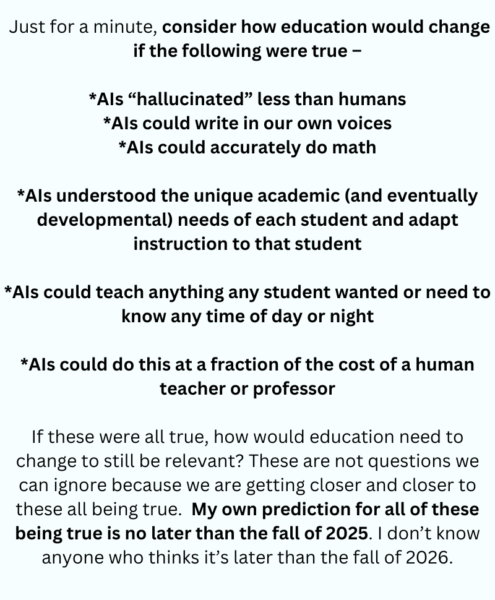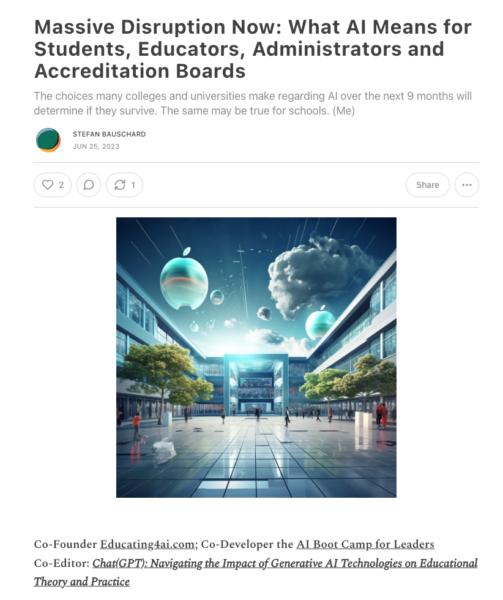
A long time ago I studied Christopher Marlowe’s play Edward II as a set text for “A” level. As was my wont, I scoured the meager resources of the school library for as much information and commentary on the play as I could. I came across the expression “haughty indifference” in a description of the character of Mortimer. It captured his arrogant superiority and condescension well and so I promptly borrowed it for my essay.
When Mr. Caws handed the essays back to the class he commented favorably on my choice of words. I can still feel the mix of surprised pride and guilt at the mention.
Fast forward several decades to when I was a high school administrator and regularly had hapless students hauled before me by righteous teachers who had caught miscreants plagiarising their essays. Online tools and plagiarism detectors had made such cheating easier and also easier to spot.
There was often something a tad triumphant in the righteous folks who had discovered the miserable cheats trying to game the system. I always had mixed feelings.
Cheating is bad, obviously. But the teacherly indignation and personal affront were sometimes over the top. I confess to often feeling sympathy for the accused especially when I considered some of the lifeless and trite topics on which they were expected to have had interesting and entirely original thoughts.
But cheating is cheating, honesty matters, lessons have to be learned, and all that other guff, so penalties were meted out and etc. The best I could do was to see if I could help the kid find a way to make reparations, save face, and – with luck – learn something useful and not do it again.
I sometimes took to commenting that the school’s own plagiarism policy was actually plagiarised. This observation was generally not well received and indeed it was not very helpful.
But all that is now ancient history. Here comes AI
I’m still trying to digest and think about this piece by Stefan Bauschard that I found on Will Richardson’s LinkedIn
My EdThinking brain has gone a bit rusty now that I’m no longer active in that world and my AI brain has hardly started cranking. But the old nut did find some connections even at first read, providing an initial cognitive grip.

What does this mean for K-16?
What does this mean for students?
What does this mean for teachers?
What does it mean for administrators?
What does it mean for governing and licensing bodies?
Important Things to Understand
Those are the headers and here are just a few of the lines that stood out on that first reading
“basic notions of equality and equity are why public schools need to get their acts together and step-up to the plate and prepare for the AI-world.”
“Teachers may not lose their jobs, but the nature of what we need K-12 teachers to do will change and individuals who can adapt to this environment will be the best (and perhaps the only) teachers.”
“It’s more important than ever to teach people how to live a good life and how to collaborate with other people and collaborate with artificial intelligence and robots.”
And so I turned to my pal the Chatbot and asked it to identify the challenges and opportunities for education in the context of AI’s potential impact.
Challenges for education outlined in the article:
- Slow adoption of AI in education: Many educators have been slow to embrace AI’s potential in the field of education, primarily due to a focus on the present rather than the future.
- Uncontrolled plagiarism: Educators have become aware of students using AI models like ChatGPT to write papers, and the problem is expected to grow as these tools become more widespread and sophisticated.
- Cyborg students: Students who leverage AI tools and bots can produce higher-quality work and acquire knowledge and skills beyond their peers, potentially creating an inequality gap in education.
- Cyborg instructors: Educators who understand and effectively use AI in their teaching can provide more relevant instruction, attract future-oriented students, and create engaging classroom environments.
- Decentralization of education: As e-learning platforms and teaching bots advance, traditional schools may lose their central role as the primary source of knowledge, leading to a more decentralized education system.
- Social issues: Counterfeit human photos and voices can cause disruptions and false accusations, while social media addiction and manipulation pose risks, potentially affecting student well-being and democracy.
Opportunities for education outlined in the article:
- Enhanced AI capabilities: AI models with reduced hallucination, the ability to write in human voices, and accurate math skills can revolutionize education by adapting instruction to individual students and providing learning opportunities at any time.
- Cost-effective education: AI-driven instruction can be provided at a fraction of the cost of human teachers, potentially making education more accessible and affordable.
- Decentralized learning opportunities: Students can access low-cost learning options and develop skills outside of traditional schools, which can be complemented by AI tools and resources.
- Curriculum co-design: Students can become active participants in shaping their own learning experiences, collaborating with teachers and AI tools to design personalized curricula.
- Adaptation and professional development: Educators who embrace AI and actively seek professional development opportunities can become better equipped to teach in an AI-driven world and create engaging learning environments.
- New assessment methods: Assessments need to evolve to reflect the changing landscape of education, considering AI’s role in tasks and focusing on tracking trajectories of student learning rather than relying solely on traditional assignments.
- Soft skills integration: The importance of soft skills such as communication, leadership, and critical thinking will increase in an AI-dominated future, and educators can incorporate them into their teaching to prepare students for the new workforce requirements.
Lots to think on. Clearly, we are either living in exciting times or approaching the end of the world as we have known it. Or – somewhere in between.
So schools: What’s your AI Policy and Plan?
The featured image is a detail from a 15th-century manuscript illustration depicting Roger Mortimer and Queen Isabella in the foreground. Background: Hugh Despenser the Younger on the scaffold, being emasculated. All of which is, of course, entirely irrelevant to schools and AI





Many great thoughts! Thank you.
Having studied “AI” (the tech and the philiosophy) at university, from 1993 to 1996, it’s interesting to see the renewed interest.
“Uncontrolled plagiarism” had me pondering, as cheats have been cheating since time began.
One line of enquiry suggests that individuals who find “creative solutions” should be rewarded, as that’s how our society tends to work!!!
But also, the education system has been using AI for years to detect plagiarism, and modern tooling could model an individual’s writing style to flag unexplained shifts. Just as bank’s fraud detection systems have been doing since the 80s…
It will be interesting as AI policing collides with privacy minds.
Josie, your exploration of the intersection between haughty indifference, plagiarism, and the potential impact of artificial intelligence on education is thought-provoking. The challenges and opportunities you highlighted in relation to AI in education are significant, from slow adoption and uncontrolled plagiarism to the potential for decentralized learning and enhanced AI capabilities. It’s crucial for schools to develop comprehensive AI policies and plans to navigate these changes effectively. Your post raises important questions and encourages us to consider the future of education in this evolving landscape.
Haughty indifference definitely a keeper.
AI scares me, but then so do guns.
Is appropriating two words plagiarism? Would AI pick them up?? I thought it was directed towards stealing whole works.
It just felt like unearned recognition at the time. I wouldn’t really call it “plagiarism’ but rather good library grazing and if in real doubt provide a reference. But that’s not what we did back in the day.
In the art world of course AI is a huge concern right now especially with it being ‘trained’ on current artists’ work with no acknowledgement or heaven forbid–compensation. What we too often forget is that the programmers behind AI are human with their own biases and technology companies with their own agendas, i.e., “a fraction of the cost”. It will indeed be a brave new world and we’re only beginning to ask the questions…
Julé Cunningham´s last blog post ..June 2023 Overview
Yes – The impact on (human!) art and music is very troublesome. And yes, AI is created by humans and therefore subject to all the prejudices and biases to which we humans are prone.
I’ve discovered that with the chatbot and – while I find it mildly amusing to wrestle it to the ground on certain controversial topics -it is also alarming what it is programmed to think and spout with such authority. (Wikipedia is also now completely unreliable (and unfixable) on certain contentious topics. What a time to be actually human.
Thinking about this makes my head hurt. It is quite terrifying. I am so glad I am not a child today.
Good points. And if AI could help with some of those intractable issues – would we listen or pay attention?
What’s for sure is that the old “study, memorize, repeat for the test” days are finally over in any place that considers itself an actual place of learning.
The editorial board of an academic journal has a set of criteria for plagiarism such that all submissions are AI screened before being sent for peer review. A recent submission which considered a literature review on an aspect of leadership in schools, drawing on over one hundred articles, was rejected because it contained over forty percent of references to writers in the field and over fifteen percent of quoted work. The meta conclusions, with evidence, were thus lost to publication. The dilemma is that unsubstantiated ideas are then rejected because of lack of evidence. I was annoyed – but Josie, great to be reminded of Brian Caws and my other sixties staff room mates.
Schools are certainly headed into complexity.
I liked Mr. Caws. He knew his stuff and did what was necessary to prepare us for the exam.
I think I was lucky in all three of my A-level teachers in that regard- Mr Beames and Mr Parry-Jones being the other two.
Always good to hear from you Derek.
Communication between people is forever fraught and complex. A life time will never sort so A1 is a non starter in such matters. We hardly know ourselves and people closest to us. Only cats know..and they aren’t tellingl
It’s a good job we never have to pass an exam on the cat mind.
And it’s also an excellent thing that cats do not communicate in human speech. (Look what happened with “Tobermory”).
Thanks for this thoughtful post regarding the looming challenges/opportunities/curses of AI. I find myself thinking about hubris — and the submersible which recently blew up while attempting to visit the wreck of the Titanic (another tragically hubristic human tale…) — whenever I hear anyone mention AI. We seem to be at the mercy these days of a bunch of techno-entrepreneurs who place (as Mark Zuckerberg once exhorted his employees) a huge value on moving fast and breaking things. G-d and Mother Earth only know what is going to unfold in the days/months/years ahead. I’d love to see how/if AI can help us with very tangible challenges such as the current cataclysm of forest fires around our planet, which are causing climate scientists to speed up their already dire predictions of global catastrophe and mayhem…
Will McMillan´s last blog post ..Time To Sing Some Songs!